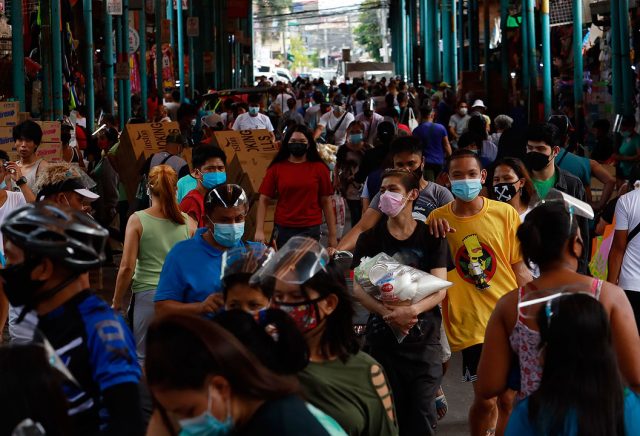Philippines now at low-risk from coronavirus

THE PHILIPPINES is now at low risk from the coronavirus amid declining infections, health authorities said on Monday.
The daily COVID-19 (coronavirus disease 2019) tally fell by 48% in the past two weeks, Health Undersecretary Maria Rosario S. Vergeire told an online news briefing. “Nationally, we are at a low-risk case classification.”
The country’s average daily attack rate — the number of infected people out of 100,000 — dropped to 5.89, she said. The country’s health system capacity was at a moderate risk level, she added.
Coronavirus cases peaked from Sept. 6 to 12, when 20,946 infections were reported daily on average, she said.
“Current average daily cases have further decreased to reach our baseline average before cases started to rise back in July,” she added.
The Philippines had an average of 5,251 daily coronavirus infections from Oct. 18 to 24, Ms. Vergeire said.
Meanwhile Ms. Vergeire said the Philippines posted its first case of the B.1.1318 coronavirus variant that triggered a virus surge in Mauritius.
She said the 34-year-old patient from Bacolod City returned to the country from Saudi Arabia on March 5. He was tested on March 10 and recovered from the virus 11 days later.
“It’s a variant under monitoring,” Ms. Vergeire said. “We have no cause for panic.
We need to be vigilant and follow minimum public health protocols.”
DoH reported 4,405 coronavirus infections on Monday, bringing the total to 2.8 million.
The death toll rose to 41,942 after 149 more patients died, whi le recover ies increased by 7,561 to 2.7 million, it said in a bulletin.
There were 57,763 active cases, 76.2% of which were mild, 6.5% did not show symptoms, 5.3% were severe, 9.72% were moderate and 2.3% were critical.
The agency said 52% of the intensive care units in Metro Manila were occupied, while the national rate was 46%.
DoH said 21 duplicates had been removed from the tally, 14 of which were reclassified as recoveries while 118 recoveries were relisted as deaths. Five laboratories failed to submit data on Oct. 23.
Ms. Vergeire said coronavirus deaths have also been decreasing since the start of October. “Highest recorded deaths were in August with 5,189 deaths or 167 deaths per day,” she said.
Coronavirus infections have decreased in the past two weeks in all regions, which were now at either low or moderate risk from the virus, she added.
Metro Mani la, Cagayan Valley, Zamboanga Peninsula, the Cordillera Administrative Region (CAR), Mimaropa and Ilocos were still at moderate risk from COVID-19.
“Majority of provinces in CAR, Regions 1, 2, 4B, and 9 remain at moderate risk classification, with beds and/or intensive care unit rates at high to critical risk,” Ms. Vergeire said.
In early August, the Philippines became at high risk from As of Oct. 25 2,761,307* total COVID-19 cases, up 4,405 new cases from Oct. 24’s 2,756,923. (*21 duplicates were removed from the total case count. Of these, 14 are recoveries.) Active cases: 57, 763 (from 60,957 previously) Recov ered: 2,661,602 (from 2,654,173 previously) Deaths: 41,942** (from 41,793 previously) (**118 cases that were previously tagged as recoveries were reclassified as deaths after final validation.) Source: Department of Health Case Bulletin as of Oct. 25, 4 PM the coronavirus after a fresh spike in infections spurred by a more contagious Delta variant.
An inter-agency task force recently relaxed the lockdown in the capital region, whose average daily attack rate decreased to 8.56 out of 100,000 people from a week earlier. The Philippines is set to allow the pilot run of face-to-face classes in low risk areas.
On Monday, Educat ion Secretary Leonor M. Briones said 90 schools, five of which are in the Calabarzon region, have been cleared to participate in the limited face-to-face classes. The agency earlier said 120 schools would participate in the test.
The OCTA Research Group from the University of the Philippines on Sunday said infections in the Philippines have declined due to its vaccination program and public compliance with health protocols.
The Philippines, which scored poorly in a global index that measured the recovery of more than 100 countries from the coronavirus pandemic, targets to inoculate at least 50% of its adult population by year-end.
The delivery of coronavirus vaccines to provinces remained a challenge, vaccine czar Carlito G. Galvez, Jr. said at the weekend.
The Philippines has 10 million coronavirus vaccine doses in its warehouses that are ready for distribution, while 40 million doses were ready to be given out, he said. —
Kyle Aristophere T. Atienza
